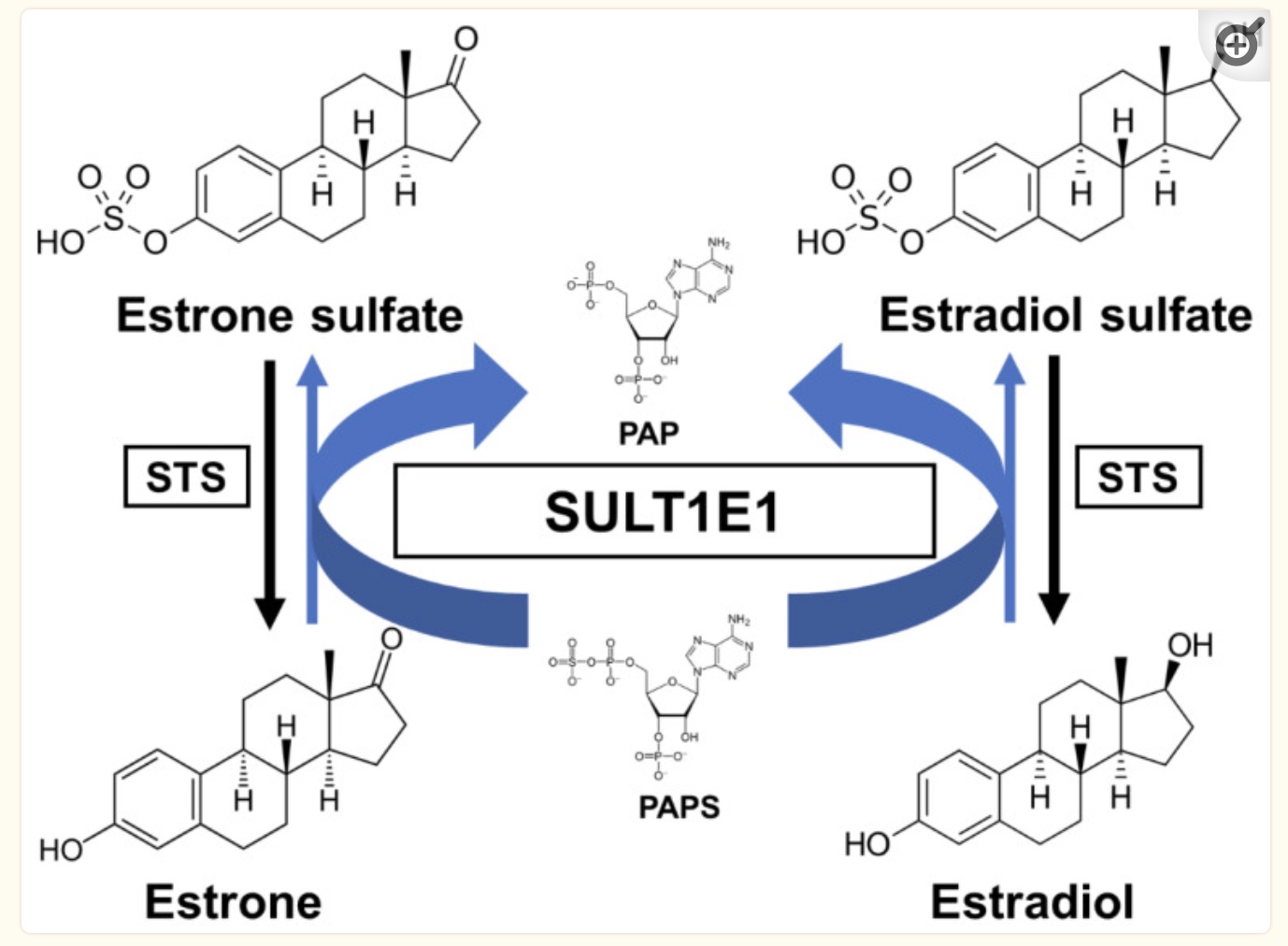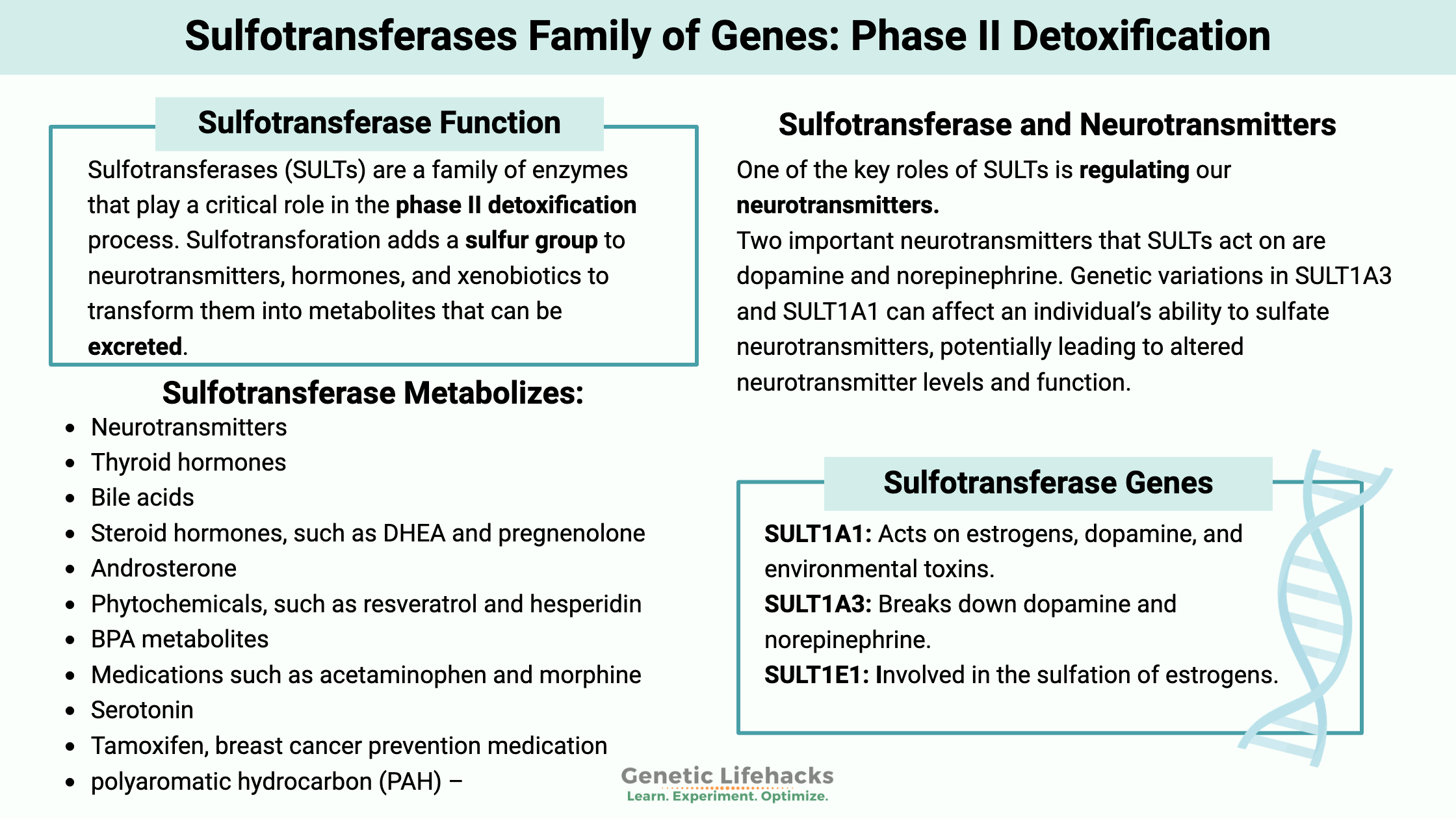Key takeaways:
~ Sulfotransforation adds a sulfur group to neurotransmitters, hormones, and xenobiotics to transform them into metabolites that can be excreted.
~ These enzymes play an important role in our body’s phase II detoxification processes.
~ Your genetic variants in the SULT family of genes can impact how well these enzymes work.
This is part of a series of articles on phase I and II detoxification.
<b>Members</b> will see their genotype report below and the solutions in the Lifehacks section. <a href=”https://www.geneticlifehacks.com/membership/”>Consider joining today</a>.
Sulfotransferases: The Unsung Heroes of Phase II Detoxification
Click to listen to this article:
Sulfotransferases (SULTs) are a family of enzymes that play a critical role in the phase II detoxification process. These enzymes take substances that need to be eliminated, such as hormones, toxicants, and neurotransmitters, and attach a sulfur-containing molecule called a sulfonate group (SO3–). This process, known as sulfation or sulfonation, makes the substances more water-soluble so that they can be eliminated.
Rabbit trail: Sulfates and sulfonates are both used in shampoos and cleaning products as anionic surfactants — able to bind to substances, break them up, and make them easy to wash away with water.
The SULT1 family of enzymes transfers a sulfate group from the sulfate donor, 3′-phosphoadenosine 5′-phosphosulfate (PAPS), to the substance that is being changed. [ref]
Sulfotransferase and neurotransmitter levels:
One of the key roles of SULTs is regulating our neurotransmitters, the chemical messengers that allow our nerve cells to communicate. Two important neurotransmitters that SULTs act on are dopamine and norepinephrine, which are part of a class called catecholamines. The primary sulfotransferases involved in neurotransmitter sulfation are SULT1A3 and SULT1A1, and adding the sulfate group inactivates the neurotransmitter.
Let’s use dopamine as an example – but keep in mind that the concepts here apply to other neurotransmitters as well.
Dopamine is a neurotransmitter that is released from neurons and then attaches to receptors on other neurons to send a signal. This all has to happen at the right level — too little dopamine causes depression and apathy, but too much dopamine is neurotoxic.
Dopamine can be broken down by three different enzymes – COMT, MAO, and SULT1A. The COMT and MAO enzymes act on higher levels of dopamine outside of the cell (intracellular space). The SULT1A enzyme acts inside the cell, such as inside a neuron that received the dopamine signal, and breaks down dopamine even at low concentrations.
SULT1A3 is the main enzyme responsible for the sulfation of dopamine throughout the body. By adding a sulfate group to dopamine, SULT1A3 converts it into dopamine-3-O-sulfate, which is a biologically inactive form of the neurotransmitter. This sulfated metabolite makes up approximately 90% of the circulating dopamine.[ref]
In the brain, both SULT1A3 and SULT1A1 are thought to be involved in the neuronal metabolism of dopamine.[ref] Sulfation of neurotransmitters is essential for maintaining proper balance and function of the nervous system. Genetic variations in SULT1A3 and SULT1A1 can affect an individual’s ability to sulfate neurotransmitters, potentially leading to altered neurotransmitter levels and function.

Interestingly, dopamine is also synthesized in the gut and plays a role in gastric motility. It can also be ingested from food or drugs. SULT1A3 is involved in the conversion of this peripheral dopamine by sulfoconjugation.[ref]
The gut-brain axis comes into play here. Inhibiting SULT1A in the gut can increase brain dopamine and tyrosine levels in the plasma.[ref] One theory of ADHD symptoms is that dopamine levels are too high in certain brain regions, and studies have shown a link between SULT1A inhibition and ADHD symptoms. Artificial food colorings and certain natural polyphenols are SULT1A inhibitors in the gut.[ref] This may be the link between ADHD and artificial colors, but I don’t think that the research is definitive here.
Estrogen metabolites and sulfation:
Another important role of SULTs is in the metabolism of estrogen and its related compounds. The main sulfotransferases involved in estrogen sulfation are SULT1E1 and SULT1A1.

SULT1E1 is the primary enzyme responsible for the sulfation of estradiol (E2), the most potent form of estrogen. By adding a sulfate group to estradiol, SULT1E1 converts it into estradiol-3-O-sulfate, which is a biologically inactive form of the hormone. Note that sulfation is only part of the picture with estradiol metabolism, and it can also be broken down with other pathways.[ref]
- Catechol estrogens: SULT1A1 is involved in the sulfation of these catechol estrogens, which can help detoxify them and reduce their potential harmful effects. Catechol estrogens are metabolites of estradiol that have been linked to increased risk of certain cancers, particularly breast cancer.
- Estrone (E1): Both SULT1E1 and SULT1A1 can sulfate estrone, another important estrogen. The sulfation of estrone produces estrone-3-O-sulfate, which is also biologically inactive.
Related article: Estrogen Metabolism Genes
SULTs also help break down estrogen-mimicking compounds we’re exposed to in the environment, like phthalates. Found in plastics, solvents, additives, and more, phthalates are ubiquitous in our modern environment. Phthalates are broken down by hydrolysis and then the phthalate metabolites can be sulfated for excretion. However, worryingly, phthalate metabolites can strongly inhibit the SULT family of enzymes.[ref]
Other sulfation targets in the body:
Beyond neurotransmitters and estrogen, SULTs have a wide range of other targets, including:[ref]
- Thyroid hormones
- Bile acids[ref]
- Steroid hormones, such as DHEA and pregnenolone (note that the sulfated form is also active as a hormone)
- Androsterone (hormone)
- Phytochemicals, such as resveratrol and hesperidin
Related article: Resveratrol: Genetic Interactions and Bioavailability
- BPA metabolites
- Medications such as acetaminophen and morphine
- Serotonin
- Breast cancer prevention drugs tamoxifen [ref], synthetic estrogens
- polyaromatic hydrocarbon (PAH) – carcinogens in smoked meat[ref][ref]
There are a couple of drugs that are taken in the ‘pro-drug’ form and have to be sulfated to be active. For example, minoxidil (hair loss drug) is activated by one of the SULT enzymes in the hair follicles to form the active drug, minoxidil sulfate.[ref]
SULT family of genes:
SULTs are divided into three main families: SULT1, SULT2, and SULT4. Each family has its own specific substrates and functions, and genetic variations in these enzymes can significantly impact an individual’s ability to process and eliminate certain substances.
SULT1 Family: The SULT1 family is primarily responsible for the sulfation of phenolic compounds, including neurotransmitters, hormones, and various drugs. Some key genes in this family include:
- SULT1A1: Acts on estrogens, dopamine, and environmental toxins. Certain variants have been linked to lower enzyme activity and increased cancer risk. (See the genotype report)
- SULT1A3: Breaks down dopamine and norepinephrine. Variants may affect neurotransmitter levels and neurological disorders.[ref]
- SULT1E1: This enzyme is primarily involved in the sulfation of estrogens. Genetic variations in SULT1E1 have been associated with differences in estrogen metabolism and risk of hormone-related cancers.
SULT2 Family: The SULT2 family mainly deals with steroid hormones and bile acids. A notable gene in this group is SULT2A1, which is crucial for metabolizing DHEA, a precursor to other steroid hormones. Variants have been associated with conditions like PCOS and osteoporosis.
Genotype report:
Lifehacks:
First, I want to point out that sulfotransforation is a huge topic with many different factors involved. It isn’t as simple as ‘everyone should eat more sulfur-rich foods or take a supplement’ for a specific genetic SNP.
As explained above, the sulfotransferase enzymes are important for the detoxification of certain toxins, but they are also involved in sulfating hormones in ways that create active products. Sulfation of neurotransmitters is also essential in the right amount — not too much, not too little.
Dietary considerations:
Related articles:
Glucuronidation: UGT Genetic Variants, Detoxification, and Hormone Balance

